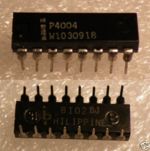Difference between revisions of "Intel 4004"
m (Jnc moved page I4004 to Intel 4004 over redirect: Naming system) |
(Proper cat, +links) |
||
| Line 1: | Line 1: | ||
[[Image:i4004.jpg|150px|thumb|right|i4004]] | [[Image:i4004.jpg|150px|thumb|right|i4004]] | ||
| − | The Japanese company [http://en.wikipedia.org/wiki/Busicom Busicom] contracted | + | The '''Intel 4004''' [[microprocessor]] resulted when the Japanese company [http://en.wikipedia.org/wiki/Busicom Busicom] contracted [[Intel]] in 1969 to create a [[integrated circuit|chip]] set for a [[printer]]-calculator. |
| − | + | Busicom permitted Intel to use the chipset design for non-calculator applications (the year this happened was 1971, according to sources). The [[Central Processing Unit|processor]] chip was called the 4004 and sold for $200. This was the first commercially available microprocessor. It was designed by [http://en.wikipedia.org/wiki/Federico_Faggin Federico Faggin], who in 1974 left Intel and started [[Zilog]]. | |
| − | Data and address information were multiplexed on a 4-bit bus. The need to multiplex the buses was part of the constraints caused by using a 16-pin DIP (40-pin DIPs were already in use by competitors at the time), enforced by Intel's management. Multiplexing reduced the instruction execution speed that could have been achieved, for example. | + | The 4004 (see picture) came in a 16-pin [[Dual Inline Package|DIP]][1] and had some limitations when compared to later microprocessors. It could only execute code out of erasable [[Read-only memory|ROM]], [[Random Access Memory|RAM]] was only used for storing data, and this complicated the life of the [[programmer]] somewhat. The chip also needed a lot of support [[logic]]. |
| + | |||
| + | Data and address information were multiplexed on a 4-bit [[bus]]. The need to multiplex the buses was part of the constraints caused by using a 16-pin DIP (40-pin DIPs were already in use by competitors at the time), enforced by Intel's management. Multiplexing reduced the [[instruction]] [[execute|execution]] speed that could have been achieved, for example. | ||
The 4004 was only the processor part of the chip set produced for Busicom. The original setup was known as 'The 4000 Family', aka 'Busicom Chip Set', aka 'MCS-4 Chip Set' and consisted of: | The 4004 was only the processor part of the chip set produced for Busicom. The original setup was known as 'The 4000 Family', aka 'Busicom Chip Set', aka 'MCS-4 Chip Set' and consisted of: | ||
| Line 18: | Line 20: | ||
---- | ---- | ||
<small>[1]Note that the BYTE article incorrectly states that the chip came in an ''18''-pin DIP.</small> | <small>[1]Note that the BYTE article incorrectly states that the chip came in an ''18''-pin DIP.</small> | ||
| − | [[Category:Microprocessors]] | + | |
| + | [[Category: Intel Microprocessors]] | ||
Revision as of 02:21, 3 November 2018
The Intel 4004 microprocessor resulted when the Japanese company Busicom contracted Intel in 1969 to create a chip set for a printer-calculator.
Busicom permitted Intel to use the chipset design for non-calculator applications (the year this happened was 1971, according to sources). The processor chip was called the 4004 and sold for $200. This was the first commercially available microprocessor. It was designed by Federico Faggin, who in 1974 left Intel and started Zilog.
The 4004 (see picture) came in a 16-pin DIP[1] and had some limitations when compared to later microprocessors. It could only execute code out of erasable ROM, RAM was only used for storing data, and this complicated the life of the programmer somewhat. The chip also needed a lot of support logic.
Data and address information were multiplexed on a 4-bit bus. The need to multiplex the buses was part of the constraints caused by using a 16-pin DIP (40-pin DIPs were already in use by competitors at the time), enforced by Intel's management. Multiplexing reduced the instruction execution speed that could have been achieved, for example.
The 4004 was only the processor part of the chip set produced for Busicom. The original setup was known as 'The 4000 Family', aka 'Busicom Chip Set', aka 'MCS-4 Chip Set' and consisted of:
- The processor (the 4004)
- 2048-bit ROM (read only memory) with a 4-bit programmable I/O port (the 4001)
- 4-registers x 20 locations x 4-bit RAM (programmable memory) with a 4-bit output port (the 4002)
- A shift register type memory with serial input and parallel output (the 4003)
References
- BYTE Volume 3, number 7, July 1978, "The First Ten Years of Amateur Computing"
- www.intel4004.com
[1]Note that the BYTE article incorrectly states that the chip came in an 18-pin DIP.
